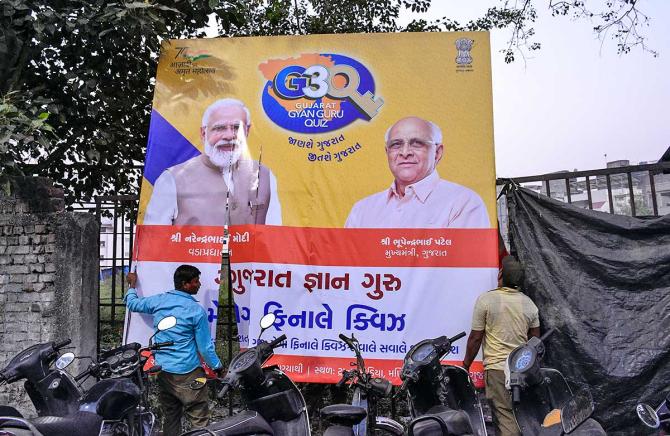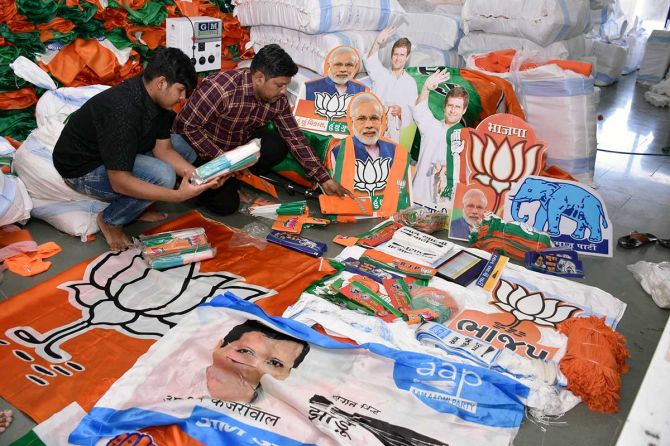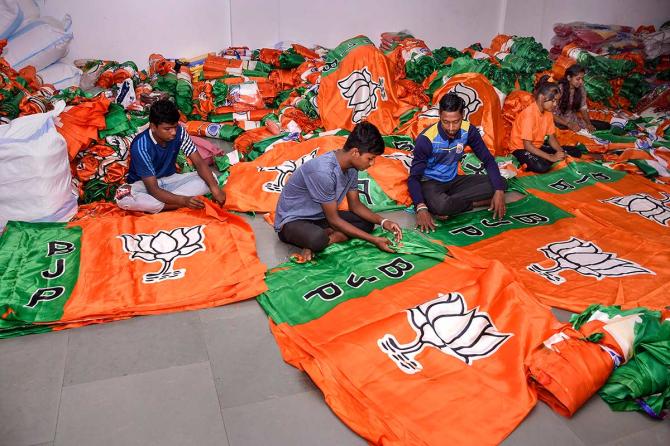The Congress won 77 seats or 42% of seats in the 2017 polls. How then can Gujarat be called a BJP bastion, asks Sanjeev Nayyar.

Ever since the Bharatiya Janata Party wrested Gujarat from the Congress in 1995 and more so since Narendra Modi became chief minister in October 2001, the state's assembly elections attract disproportionate national attention.
It is assumed and stated that Gujarat is a BJP bastion.
But is it?
See table below to know the truth.
Number of seats won by BJP and Congress in Gujarat -- 1998 to 2017
The Congress won 77 seats or 42% of the total number of seats in the 2017 election.
How then can Gujarat be called a BJP bastion?
Surely, the Congress has pockets of influence, or how else would it win 51 seats in 2002, in the aftermath of the Gujarat riots!
Rahul Gandhi led such a spirited campaign which saw the Congress tally increase from a low of 51 seats in 2002 to a respectable 77 in 2017.
Yet, the public has forgotten this Congress performance.
The party has not given enough importance to Gujarat, for which it alone is to blame.
They have given the impression, at least outside of Gujarat, that there hardly exists an Opposition in the state.

The Aam Aadmi Party wishes to be a serious contender in Gujarat and is making all-out efforts.
It is also not the case that the BJP did well in all regions of Gujarat in 2017.
In fact, it fared badly in Saurashtra (thanks to the Patidar agitation). See table below.
Region-wise seats won by BJP
In Saurashtra the BJP tally fell from 35 to 21 between 2012 and 2017. Note that in 2017 the Patidar agitation was at its peak.

The Congress vote share has been reasonably consistent, too.
Vote Share of BJP vs Congress
Wonder why the the Congress's central leadership is perceived to have given up on Gujarat?
Being in power for 27 years in a state is no mean achievement. The challenge now is to get re-elected.
As someone who is not a resident of Gujarat but has travelled throughout the state, a few developments have stayed with me.
In a 2006 article for Business Standard, I wrote about 'a unique scheme called Jyotir Gram Yojna introduced in Gujarat.'
'Due to inadequate power generation and excessive consumption by the agricultural sector, load shedding was unavoidable.
'With an investment of Rs 1,300-1,500 crore, the government decided to provide single/three-phase electricity connections to domestic and cottage industry consumers in all villages with a population more than 3,000.
'This way, line one is for agricultural and line two for domestic use.' It aimed to provide three-phase electricity to all 18,000 villages.
'This scheme (introduced in September 2003) resulted in rural development and had a multiplier effect.
'If implemented in Punjab, among other states, similar benefits could accrue.'
Any attempt to destabilise the power sector, through freebies, might be resented by voters.
Gujaratis are a dynamic, risk-taking and business-oriented community. They know that nothing comes free.

Another example is cotton.
In a 2006 article, also for Business Standard, I wrote how sops to cotton farmers in Maharashtra did not prevent farmer distress.
However, 'In neighbouring Gujarat a combination of factors ensured production increased. First, unlike Maharashtra, Gujarat didn't waste money on monopoly procurement and chose to invest it in creating irrigation.
'Also water levels across the state have gone up due to large-scale rainwater harvesting by the construction of thousands of check dams. Gujarat, also created its own brand, Shanker6.'
The state government focused on the right things and created an enabling environment that increased production and eventually people welfare.
A third example is the creation of tourism locations out of nothing, in Kutch and Kevatia. I visited the Salt desert in Kutch and Tent City, Kevatia, that is home to the State of Unity.
In a 2018 article for Rediff.com, I wrote, 'Eighty-six km from Bhuj and at one end of Kutch is the Salt Desert Dhordo. Earlier, Dhordo village was hardly visited and had poor infrastructure. The main occupation of its people was animal husbandry and handicrafts. Inadequate employment forced migration.
'It was in 2005 that a plan to develop the area was made. Tent City came up in 2008. In village Gandhi nu Gaam I met with Puna Sumar Marvada who specialises in making wood furniture, mud painting, and sells Kutchi textiles. He said the Rann Utsav was a boon. During the peak tourist season he did not have time to even breathe.'
'I also met with Mian Hussein, the sarpanch of Dhordo village, who said Tent City brought roads, development, electricity, wi-fi, water, tourists and resort facilities. With pride he added that Dhordo village also had a helipad.
'In 2015 the government constructed 20 bhungas (traditional Kutchi mud hut with thatched roof and decorative hand-painted motifs) and gave it to the village panchayat to manage.'
In 2020 I visited the Tent City and Statue of Unity.
Like in Dhordo, Kutch, an amazing tourist attraction, was created out of nowhere and in a backward area.
Friends who visited in 2022 returned very happy. The Taj Group is planning to open a hotel there shortly.
Saurashtra and Kutch are water deficit areas hence Narmada Dam is an emotional issue in Gujarat.
According to a July 2022 Indian Express report, 'Narmada waters reached Mod Kuba, a village in Mandvi taluka of Kutch district, through the Kutch Branch Canal, 750 km from the Narmada dam.'
Saurashtra and North Gujarat regions are already receiving Narmada waters.
It is in Gujarat's interest to start an afforestation programme in Amarkantak, source of the river in Madhya Pradesh.
Voters tend to forget the work done over the years and take the present for granted.
The above examples were written earlier and are being recalled because these are innovative ideas and solutions.
Having said that, the BJP needs to talk about what it will do and not over dwell on past achievements.

In 2017 the BJP was adversely affected by unhappiness due to demonetisation and GST. The latter has stabilised now.
The BJP needs to release its manifesto in time unlike in 2017.
So also the BJP had failed to anticipate and address rural discontent in 2017 especially in Saurashtra.
If it has not made amends in the last five years, expect the Congress/AAP to take advantage.
The BJP state leadership at the top are 60-plus. Will they be able to connect with the youth?
The BJP must not take voters for granted. Hurting their ego could be dangerous.
The BJP needs to be careful of opponents who might try to create examples of violence against backward classes.
Recall the thrashing of Dalits in Una in 2016 went against the BJP in the 2017 poll.
Yet as battle lines are drawn, a live recording of such created events and making video viral is a distinct possibility.

Now some notes for the BJP/Congress/AAP.
For years the BJP ignored and refused to critically evaluate the AAP government's claims to good governance in Delhi.
Now that AAP is fighting the BJP in Gujarat and Himachal, the BJP has woken up. CBI actions seem to be a result. Time will tell whether AAP makes inroads.
Readers might recall that in 2017 there were similar raids in the run-up to Ahmed Patel's re-election to the Rajya Sabha.
Income-tax raids on a then Karnataka minister made people perceive that the government's actions were driven by emotion than reason.
The raids did not affect the Congress. In fact, their seats went up from 51 to 77.
We will have to wait and see if the Delhi raids impact AAP's chances. Either way, do not underestimate the Congress and AAP.
What might go against both these parties is their very pro-Muslim stand.
The recent riots and killings of Hindus in Congress-ruled Rajasthan is surely not lost on the Gujarat electorate.
The AAP government in Delhi is visibly pro-Muslim. Remember that the recent Hindu-Muslim riots in Delhi occurred, after a long gap, during AAP rule even though law and order in Delhi comes under the Centre.
This impression is so strong that the Congress/AAP can do little to change it.
Expect the Congress/AAP to question the government's performance on indicators like nutrition, health, education and unemployment.
AAP promises freebies to woo voters. One such freebie promised in Punjab was a monthly stipend of Rs 1,000 per month to women above 18.
The scheme, whose estimated annual cost is at least Rs 10,000 crores (Rs 100 billion), is yet to be implemented post the February 2022 elections. Some say the government has five years to fulfill its promises.
Sanjeev Nayyar is a chartered accountant, founder www.esamskriti.com and a Punjabi by birth.
Feature Presentation: Rajesh Alva/Rediff.com










